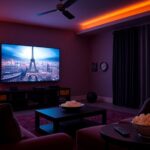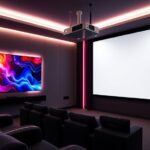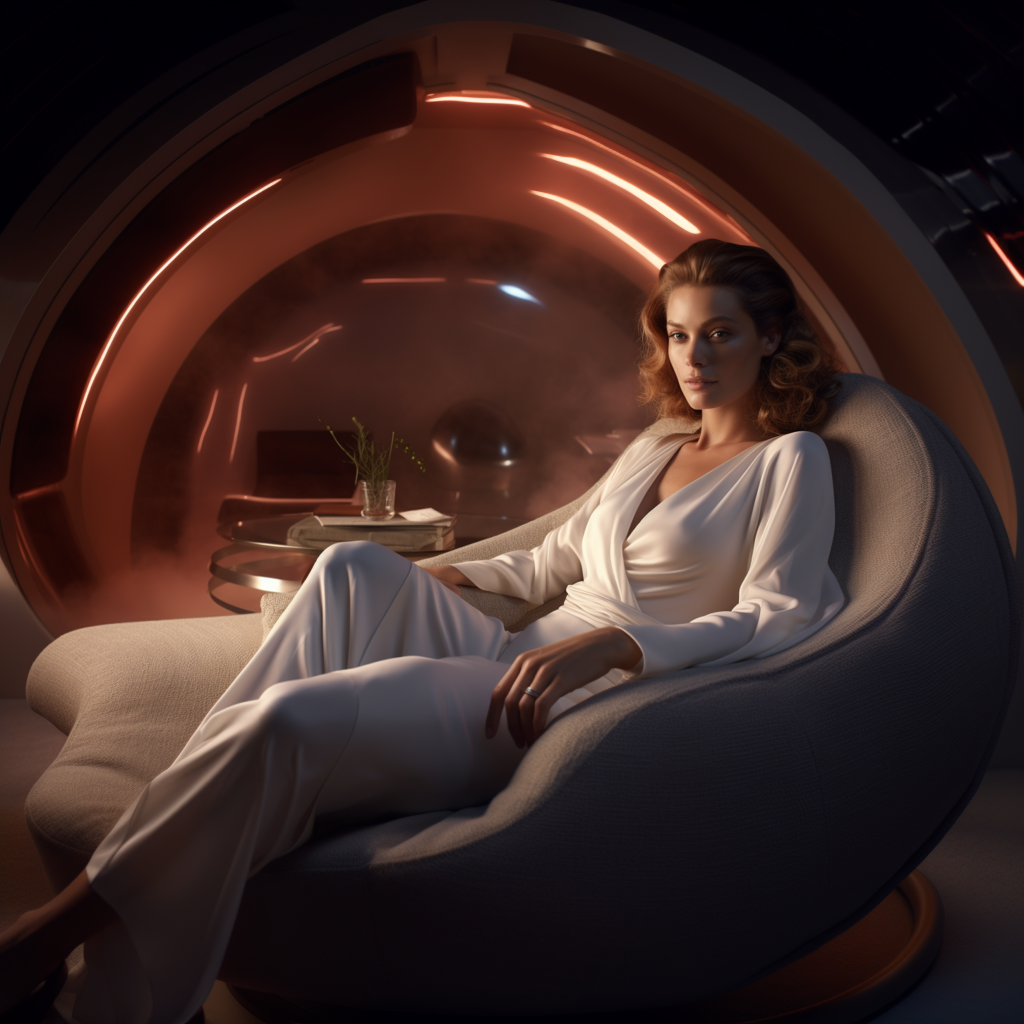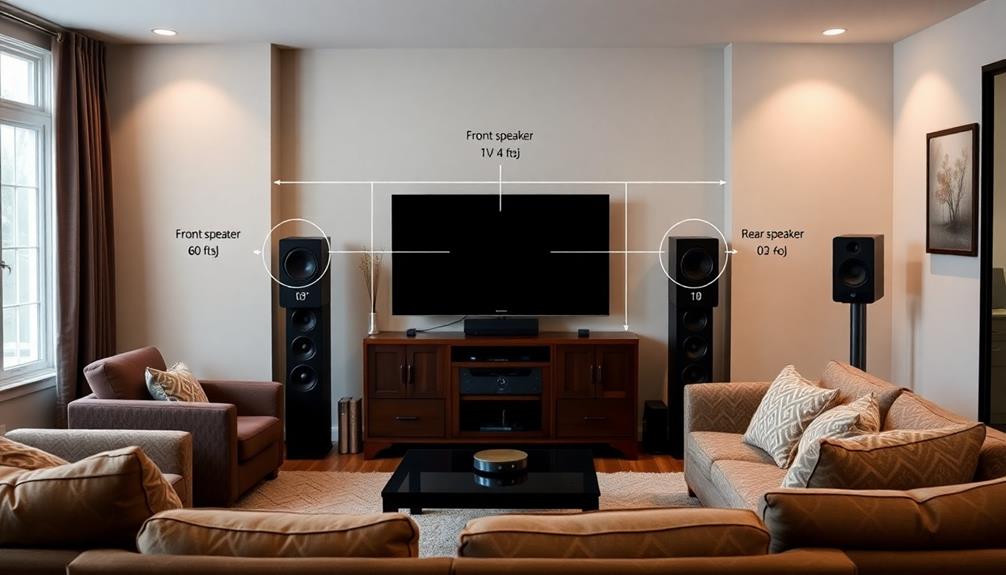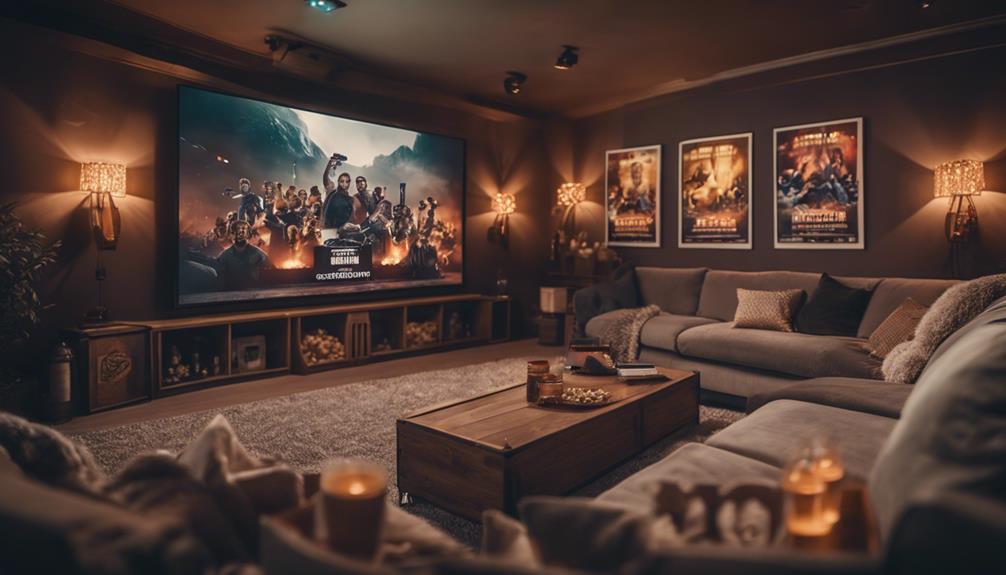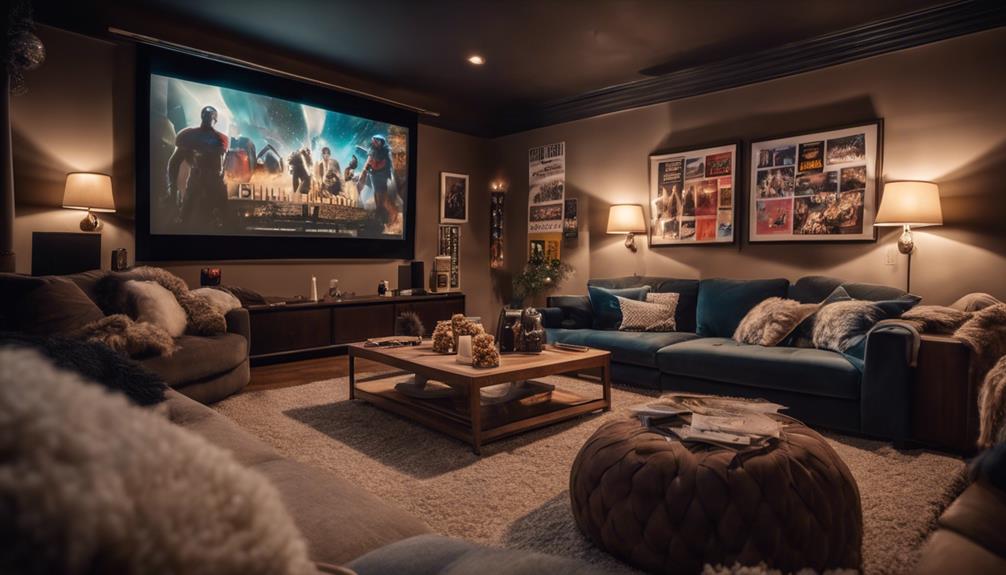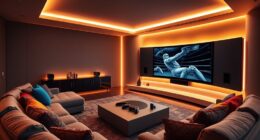If you're looking to enhance your sports and action movie experiences, projector frame interpolation is a game-changer. It generates extra frames for smoother motion, essential for large screens over 120 inches. You'll notice improved clarity, especially during fast-paced scenes, making it easier to follow all the action. However, be mindful of your projector's settings and potential drawbacks like the "Soap Opera Effect" with traditional films. Customizable options let you tailor the experience to your preference. Curious how to maximize your setup for the best performance? There's more to explore that can take your viewing to the next level.
Key Takeaways
- Frame interpolation significantly improves motion clarity in sports, allowing viewers to follow fast-paced action without motion blur or judder.
- Action movies benefit from enhanced smoothness, but caution is needed to preserve the director's original intent and emotional pacing.
- Customizable settings in projectors enable tailored frame interpolation, optimizing the viewing experience for both sports and action films.
- Compatibility with advanced projectors is crucial, as settings like 4K Enhancement and IMAGE PROCESSING impact frame interpolation performance.
- Future trends in interpolation technology, including AI advancements, promise to reduce motion artifacts and support higher frame rates for smoother visuals.
Understanding Frame Interpolation

When you watch fast-paced content like sports or action movies, you might notice motion blur or judder that can detract from the experience. This is where Frame Interpolation (FI) comes in. FI generates intermediate frames between the original video frames, enhancing motion clarity and reducing judder. This technology is particularly beneficial for larger screens, especially those over 120 inches, where motion judder becomes more noticeable.
Different manufacturers have their own terms for this technology; for instance, Epson calls it "Frame Interpolation," while others might refer to it as "Smooth Motion" or "Frame Creation."
However, while FI delivers a smoother viewing experience, it's crucial to be cautious. Using Frame Interpolation for traditional films shot at 24 frames per second can lead to an unwanted "Soap Opera Effect," altering the filmmaker's intended visual storytelling.
To get the best performance from FI, you need to understand your projector settings. You may have to turn off features like 4K Enhancement and adjust your IMAGE PROCESSING settings.
Benefits for Sports Content

When you're watching sports, frame interpolation can transform your experience by enhancing motion clarity and reducing blur during those fast-paced moments.
You'll find it easier to follow the action, whether it's a player sprinting down the field or a ball soaring through the air.
Plus, many projectors let you customize the effect, so you can tailor the viewing experience to your liking.
Enhanced Motion Clarity
In the world of sports broadcasting, frame interpolation transforms the viewing experience by dramatically enhancing motion clarity. This technology creates additional frames between the original frames, resulting in smooth motion that allows you to enjoy fast-paced action without the distraction of motion blur.
When you're watching a game on a larger screen, frame interpolation minimizes motion judder, making every thrilling moment even more immersive.
With frame interpolation, you can maintain detail in rapid scenes, enabling you to track players and the ball effortlessly. This clarity is vital during critical plays, where every second counts.
Many modern projectors even allow for customization of frame interpolation settings, so you can fine-tune the effect to match your preferences and the type of sports content you're viewing.
Ultimately, using frame interpolation in sports broadcasts leads to an enhanced viewing experience. You'll find greater satisfaction and engagement during live events and high-action sequences, making it feel like you're right there in the stadium.
Reduced Motion Blur
Frame interpolation not only enhances motion clarity but also greatly reduces motion blur, making it a game-changer for sports content. When you're watching fast-paced games, the last thing you want is to struggle with blurry images that make it hard to follow the action.
With frame interpolation, additional frames are generated, resulting in smooth motion that lets you clearly track players and objects as they dart across the screen. This technology greatly improves your viewing experience during high-speed action, eliminating distractions caused by motion blur.
You'll find that sports broadcasts become more engaging and lifelike, enhancing your satisfaction as you immerse yourself in the game. Plus, by reducing motion blur, frame interpolation helps alleviate eye strain during those rapid scenes, making your time spent watching sports more comfortable.
If you're viewing on a larger screen, the advantages are even more pronounced. Motion judder can be annoying, but with frame interpolation, you can enjoy a seamless experience that captures every exhilarating moment.
For sports enthusiasts like you, this technology is essential for truly enjoying the thrill of the game.
Customizable Viewing Experience
Elevate your sports viewing experience with customizable settings that allow you to tailor Frame Interpolation to your liking. This cutting-edge technology generates additional frames between original frames, resulting in smooth motion that enhances fast-paced action.
Regular maintenance for your projector can guarantee peak performance, similar to how regular cleaning is vital for peak performance of air purifiers. With the ability to adjust the level of smoothness, you can refine the viewing experience to strike the perfect balance between clarity and the game's natural feel.
Thanks to advancements in projector technology, such as the Pro Cinema LS12000, you can enjoy Frame Interpolation alongside 4K Enhancement. This combination brings deeper detail and fluid motion to sports broadcasts, making each play more immersive.
If you're using a larger screen—120 inches or more—you'll especially benefit from Frame Interpolation, as it greatly reduces motion judder that can be more distracting on expansive displays.
However, it's crucial to use viewer discretion. While Frame Interpolation dramatically improves sports content, traditional films might be best enjoyed without it to preserve the director's original intent.
Compatibility With Projectors
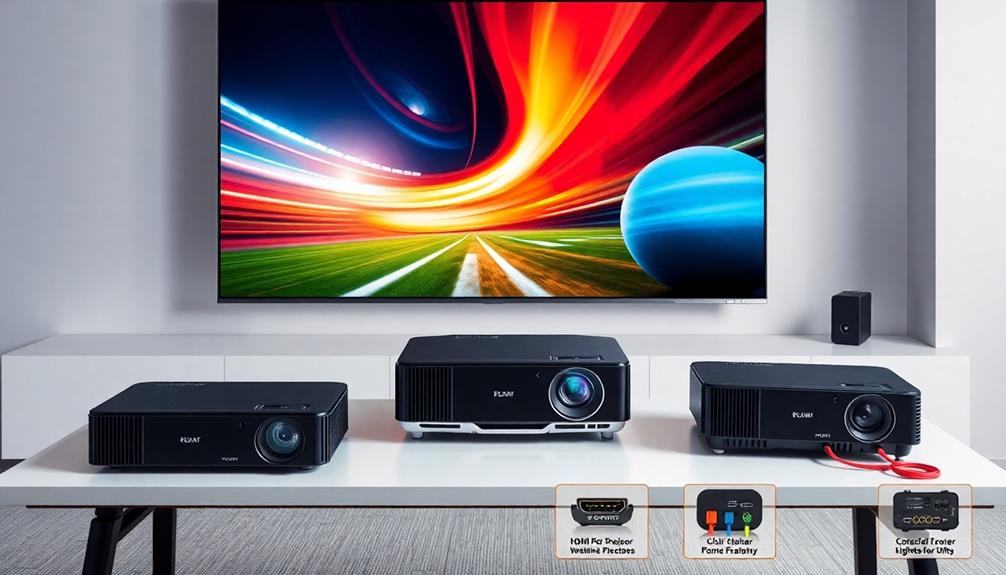
Finding the right projector for frame interpolation can enhance your viewing experience, especially for fast-paced sports. Understanding compatibility with projectors is vital to enjoy smooth motion and the best possible image quality.
| Projector Model | Frame Interpolation Support |
|---|---|
| Epson (Newer Models) | 1080P only, 4K Enhancement off |
| Epson (Older Models) | Limited with Pixel Shifting on |
| Pro Cinema LS12000 | Yes, with 4K UHD PRO at 120 Hz |
| General Requirement | IMAGE PROCESSING set to "Fine" |
| Sports Content Clarity | Noticeably enhanced with FI |
To make the most of frame interpolation, verify your projector's settings are correctly adjusted. For newer Epson projectors, keep the 4K Enhancement feature off for frame interpolation to function. If you own an older model, be mindful that enabling Pixel Shifting might limit this feature. However, the Pro Cinema LS12000 model stands out, allowing both frame interpolation and high-definition technology simultaneously. Activating the IMAGE PROCESSING setting to "Fine" is essential for achieving peak performance, especially when you're watching fast action sports, guaranteeing a visually stunning experience.
Impact on Action Movies

When you watch action movies with frame interpolation, you'll notice a significant boost in motion clarity, making fast-paced scenes much more engaging.
However, this enhanced smoothness can sometimes stray from the director's original intent, altering the cinematic experience.
As you explore this technology, you'll see how it both elevates and challenges the traditional feel of action films.
Enhanced Motion Clarity
Frame interpolation greatly enhances motion clarity in action movies, allowing you to experience high-octane sequences with remarkable detail and fluidity. This technology generates intermediate frames, reducing motion blur and creating smoother shifts during fast-paced scenes.
As a viewer, you'll appreciate the clarity it brings, making it easier to spot intricate details without the distractions of judder and stutter.
Here are some key benefits of enhanced motion clarity through frame interpolation:
- Clearer Action Sequences: You'll notice every punch, kick, and explosion without losing track of the action.
- Improved Viewing Experience: The overall fluidity enhances your immersion, especially on larger screens.
- Cinematic Integrity: Frame interpolation maintains the film's visual integrity while providing smooth motion.
- Variable Effectiveness: Newer projector models optimize frame interpolation, considerably reducing artifacts.
While frame interpolation is a game-changer for action movies, remember that excessive use can lead to the "Soap Opera Effect," which might alter the intended cinematic feel.
Enjoy the benefits, but keep an eye on how it's applied to guarantee the best experience possible!
Director's Intent Alteration
While enhanced motion clarity through frame interpolation can elevate your viewing experience, it also risks altering a director's artistic intent. When you watch an action movie, the pacing and rhythm are meticulously crafted to evoke specific emotions.
Frame interpolation introduces additional frames that may disrupt this careful balance, leading to a smoother motion that doesn't align with the director's vision. This "Soap Opera Effect" can make films feel less authentic, resembling television broadcasts rather than cinematic masterpieces.
Many directors prefer to maintain the traditional 24 fps frame rate, as higher frame rates can greatly change how you perceive a scene's emotional weight. Furthermore, technical challenges with frame interpolation may cause visual artifacts during rapid action sequences, further diverging from the original representation of motion.
As more viewers expect smoother visuals at home, filmmakers might feel pressured to adapt their techniques in future productions, potentially compromising their unique storytelling styles.
This shift could lead to an undesirable side effect: a loss of the distinct emotional and artistic nuances that define great action movies. It's crucial to reflect on how frame interpolation can impact your overall cinematic experience and the integrity of a director's intent.
Technical Challenges of Frame Interpolation

Numerous technical challenges arise with frame interpolation, particularly in dynamic scenes where motion is rapid. You might notice that while frame interpolation aims to deliver smooth motion, it can sometimes lead to undesirable artifacts.
Here are a few key challenges to take into account:
- Ghosting and Motion Smear: Fast-moving scenes can produce ghosting effects, especially in lower-quality projectors.
- Processing Power Limitations: Earlier projector models often struggle with frame interpolation due to inadequate processing capabilities, leading to inconsistent motion smoothness.
- Content Compatibility: Not all motion pictures work well with frame interpolation. Sometimes, it can detract from the film's intended cinematic feel, making it essential to choose wisely.
- Balancing Natural Motion: Finding the right settings to achieve smooth motion while preserving a natural look can be tricky and may require careful adjustments.
Understanding these technical challenges helps you make informed decisions about using frame interpolation. By being aware of the limitations and potential pitfalls, you can enhance your viewing experience while avoiding frustration with your projector setup.
Enhancing Gaming Experience

Gaming experience can be dramatically transformed with the right projector features, especially when it comes to smooth motion during intense gameplay. Frame interpolation technology plays an essential role here, providing smoother motion that enhances your immersion in fast-paced genres like first-person shooters and racing games.
With frame interpolation enabled, you'll notice reduced motion blur and judder, which leads to improved clarity and responsiveness in dynamic scenes.
Many advanced projectors give you the flexibility to toggle frame interpolation settings, allowing you to prioritize low input lag for competitive play or opt for enhanced visual fluidity for a more cinematic feel. This adaptability is vital for gamers who want to tailor their experience based on their gaming style.
Some projectors can achieve response times as low as 20ms, striking the perfect balance between quick reflexes and stunning visuals.
Furthermore, as frame interpolation technology evolves, newer models continue to minimize artifacts during fast motion, further enhancing your overall gameplay and visual fidelity.
Future Trends in Interpolation Technology

As projectors continue to enhance gaming experiences, the future of interpolation technology looks promising. You can expect significant advancements that will refine frame interpolation, leading to smoother visuals for sports and action movies.
Manufacturers are increasingly using AI and machine learning to improve motion estimation and compensation, which means you'll see less motion artifacts and a better overall viewing experience. Additionally, as energy-efficient technologies evolve, similar advancements in heat pumps will also focus on optimizing performance for varied conditions, leading to better efficiency in climate control systems.
Here are some trends to keep an eye on:
- Enhanced Accuracy: Improvements in frame generation will minimize artifacts.
- Customizable Settings: More options for tailoring motion smoothing effects to your liking.
- Higher Frame Rates: Support for 120 Hz and above could change how you experience various content types.
- MEMC Integration: Motion Estimation Motion Compensation technology is becoming standard in more models, enhancing motion fluidity while keeping input lag low.
With these trends, you'll enjoy a more immersive viewing experience, whether you're gaming or watching your favorite action-packed film.
As display technologies evolve, frame interpolation will continue to transform how you perceive motion, making it an exciting time for enthusiasts and casual viewers alike.
Frequently Asked Questions
Do Projectors Have Motion Smoothing?
Yes, many projectors do have motion smoothing features. You can enhance your viewing experience by adjusting settings to reduce motion blur during fast scenes. Just remember, it might not suit every type of content.
Does Motion Smoothing Increase FPS?
No, motion smoothing doesn't increase FPS. Instead, it generates additional frames between existing ones, creating the illusion of smoother motion. You'll notice smoother shifts, but the original content's frame rate remains unchanged.
Is Motion Smoothing Good?
Imagine watching a thrilling race; motion smoothing can feel like being in the front row, enhancing excitement. However, it's a double-edged sword—some love the clarity, while others miss the original film's charm. Choose wisely!
Do TVS Interpolate Frames?
Yes, TVs interpolate frames to enhance motion fluidity. You can adjust the settings to find a balance that suits your viewing preferences, ensuring a smoother experience without compromising image quality or introducing unwanted artifacts.
Conclusion
As you immerse yourself in the domain of projector frame interpolation, you'll discover how it transforms your viewing experience, especially for sports and action-packed films. Imagine the thrill of every play and every explosion, rendered with breathtaking smoothness. Yet, challenges remain on the horizon that could alter this technology's evolution. Will you be ready to embrace the next wave of innovation? Stay tuned—you won't want to miss what's coming next in this dynamic sphere of entertainment!
Hi, I’m Dominique. I love movies and want everyone to have the best home cinema experience possible. That’s why I started 1home Theatre Projector. We help people build their home cinema system using the latest technology and news on laser tv and all-around home entertainment.
We’re a small team of movie buffs (and experts) who are passionate about giving our readers the best advice and information possible. So whether you’re just starting out or you’re looking to upgrade your home cinema system, we’ve got you covered!



